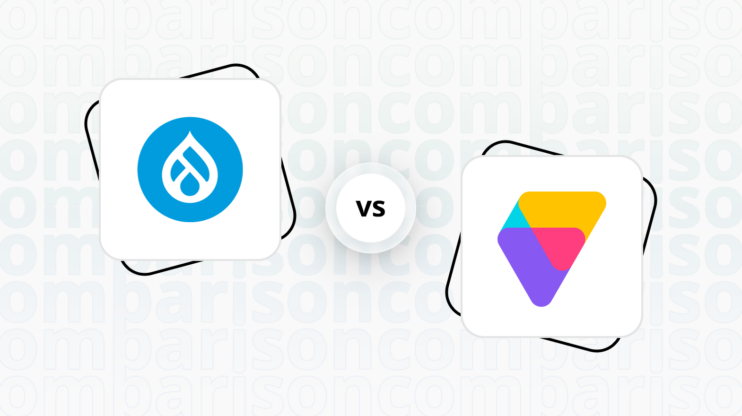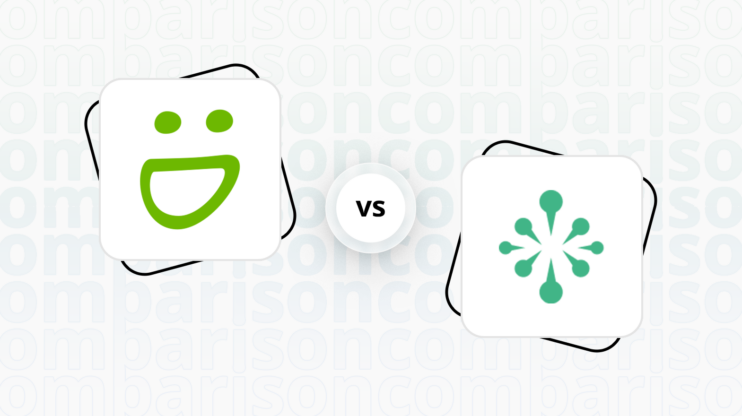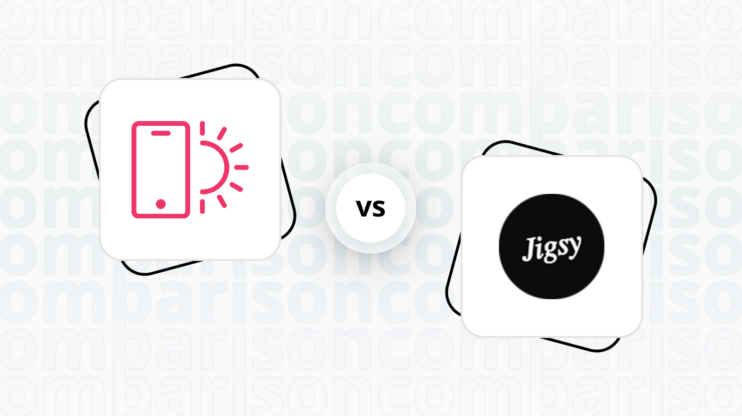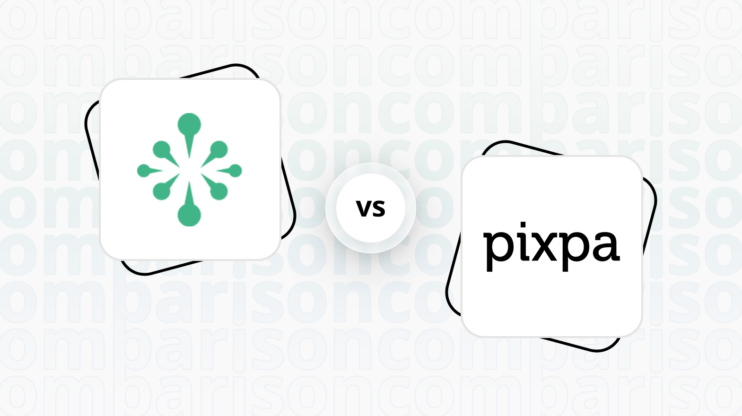Final verdict
Google Sites vs Portfoliobox both offer unique advantages, but they cater to different user needs.
-
Google Sites (Overall Grade: 5.6/10)
is ideal for users seeking a simple, collaborative platform integrated with Google services. It excels in ease of use and user management, making it a great choice for team projects, personal portfolios, and small business websites. However, it lacks advanced design functionalities and ecommerce features, which may limit its appeal for more complex projects. -
Portfoliobox (Overall Grade: 6.1/10)
is tailored for creative professionals looking to showcase their work online. It offers advanced design features, customizable templates, and integrated ecommerce capabilities, making it a versatile solution for artists, photographers, and other creatives. While it may have a steeper learning curve and fewer user management options, its comprehensive toolset and focus on creative portfolios make it a strong contender in the Google Sites vs Portfoliobox comparison.

|

|
|
|---|---|---|
|
Design functionalities & templates |
4.9 |
7.5 |
|
Ease of use |
8.3 |
8.1 |
|
Ecommerce |
1.8 |
5.8 |
|
Website editors |
7.0 |
7.5 |
|
Product testing options |
6.9 |
9.1 |
|
Price |
8.1 |
7.9 |
|
Hosting quality |
8.2 |
6.5 |
|
Website speed optimization |
3.3 |
6.4 |
|
Plugins/extensions and integrations |
6.4 |
7.2 |
|
Marketing features |
2.6 |
7.0 |
|
Customer support |
7.2 |
7.0 |
|
Website security |
9.3 |
8.1 |
|
User management |
7.8 |
2.8 |
Best for ecommerce
 1.8
1.8
 5.8
5.8
Verdict
: Google Sites vs Portfoliobox reveals that Portfoliobox is the superior choice for ecommerce, especially for creative professionals. Google Sites lacks built-in ecommerce features and relies heavily on third-party integrations, making it less suitable for online stores.
-
Google Sites
: Google Sites is not inherently designed for ecommerce. It lacks built-in features for online stores and relies on third-party integrations, which can be cumbersome. While it integrates well with other Google services, it falls short in providing a seamless ecommerce experience. Its score for ecommerce is 1.8. -
Portfoliobox
: Portfoliobox offers a more integrated ecommerce experience, specifically tailored for creative professionals. It provides essential ecommerce functionalities such as product listings, payment gateways, and order management, making it a better choice for those looking to sell their work online. Its score for ecommerce is 5.8.
Best for informational & business websites
 7.2
7.2
 7.5
7.5
Verdict
: When comparing Google Sites vs Portfoliobox, Portfoliobox slightly edges out Google Sites for informational and business websites due to its advanced design features and customization options tailored for creative professionals.
-
Google Sites
: Google Sites is a user-friendly platform that integrates seamlessly with other Google services, making it ideal for users familiar with the Google ecosystem. It offers a straightforward drag-and-drop interface and is designed for collaboration, making it a popular choice for team projects, personal portfolios, and small business websites. However, its design customization options are somewhat limited compared to Portfoliobox. -
Portfoliobox
: Portfoliobox is specifically designed for creative professionals, offering a variety of customizable templates and advanced features such as Adobe Lightroom integration and e-commerce functionality. It provides a user-friendly experience with drag-and-drop functionality, making it easy for users to create stunning websites without technical skills. Portfoliobox is particularly suitable for artists, photographers, musicians, and architects looking to showcase their work effectively online.
Detailed comparison
Design functionalities & templates
Design FunctionalitiesRepresents how well each platform allows for creative design and customization of websites.Score Components:
- Template Variety (30%): Range and quality of design templates.
- Customization (30%): Flexibility and options for design alterations.
- User Interface (20%): Ease and intuitiveness of the design process.
- Responsiveness (10%): Adaptability to different devices and screen sizes.
- Innovation (10%): Unique design features and tools.
 4.9
4.9
 7.5
7.5
🏆
Winner: Portfoliobox.
If you’re a creative professional looking for a platform with more advanced design features and customization options, Portfoliobox is the better choice.
Google Sites offers a limited number of templates (around 17) suitable for various purposes, from personal blogs to business websites. These templates are designed for user engagement, simplicity, and functionality, allowing for customization to meet specific needs. However, compared to other website builders, Google Sites might offer less variety in templates and design customization options.
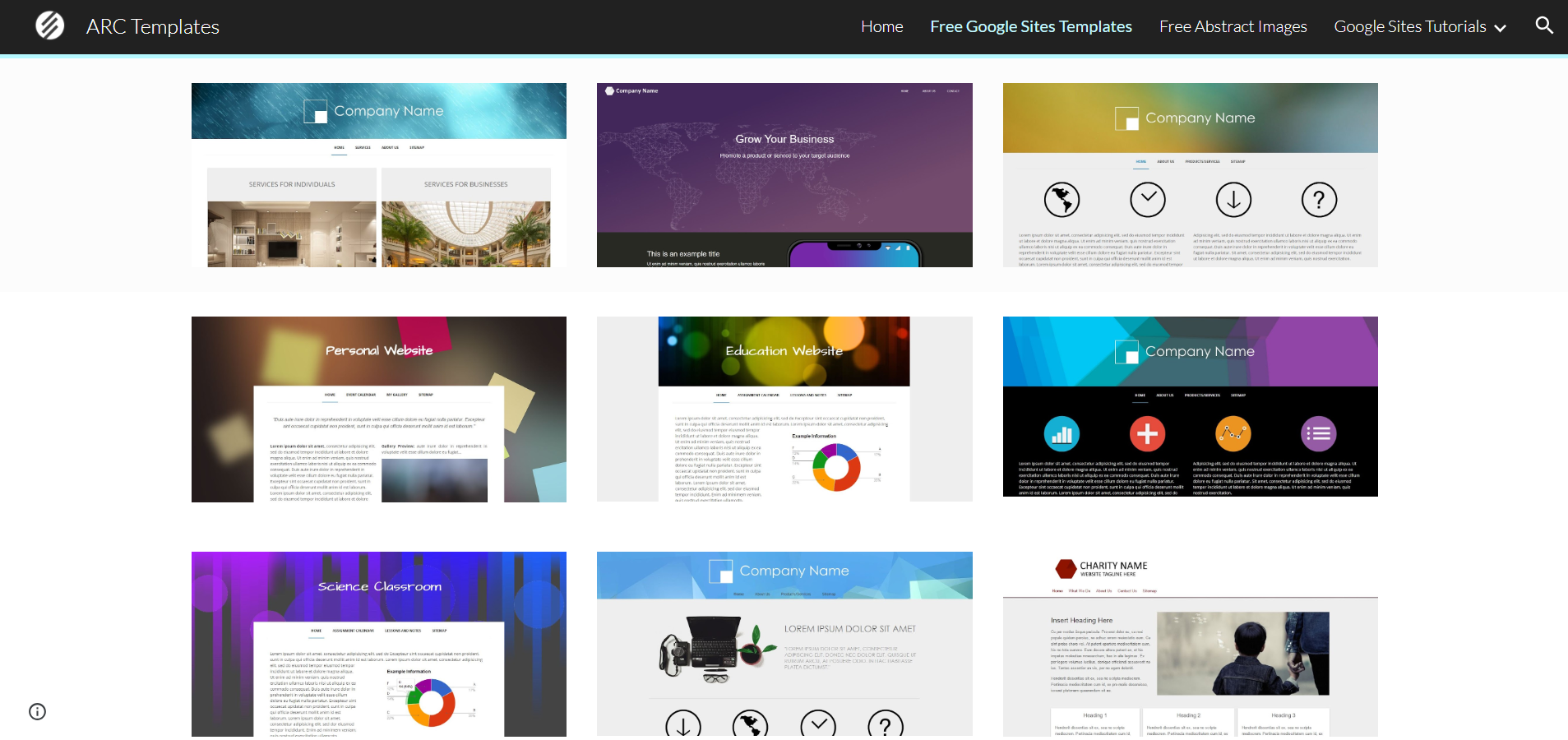
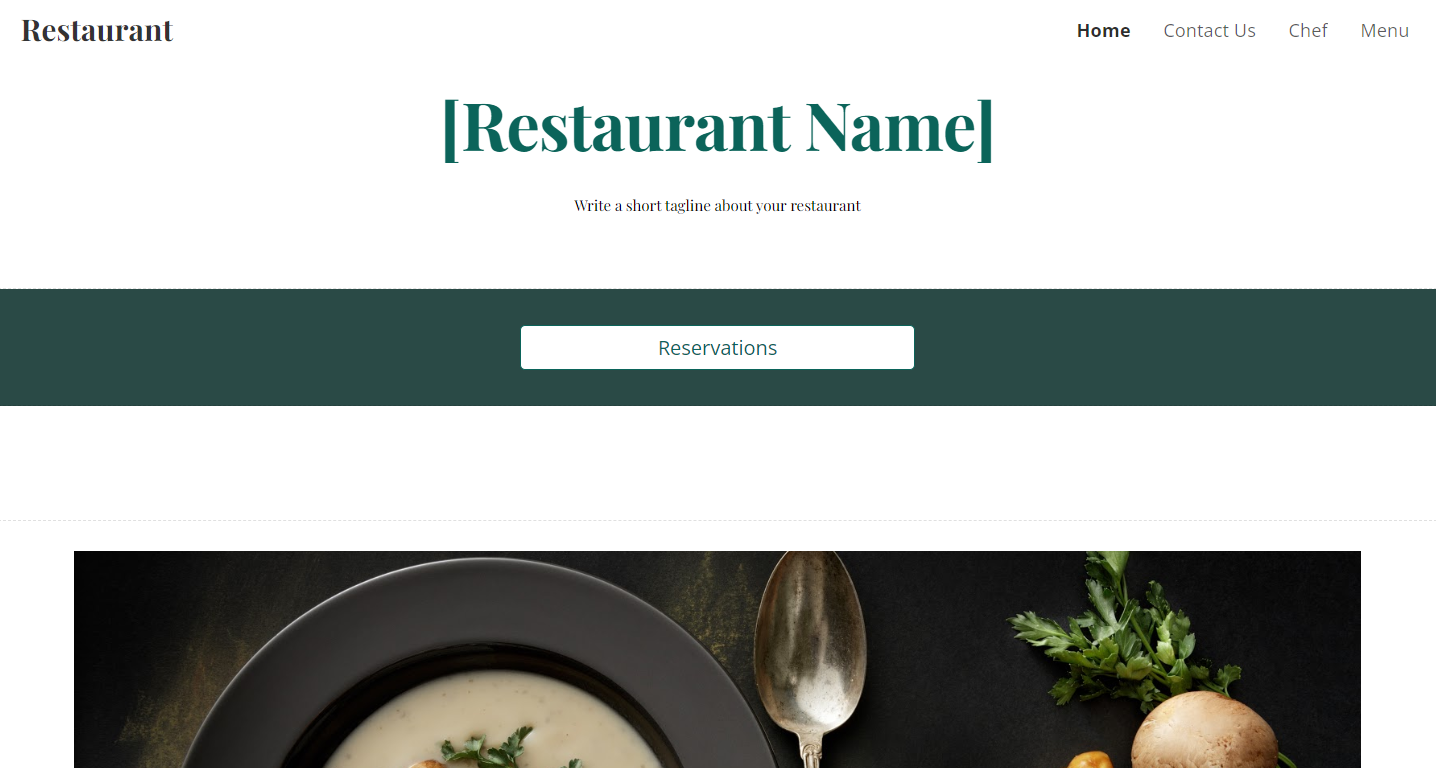
Portfoliobox, on the other hand, offers over 30 customizable templates tailored to a variety of professional needs and preferences, including galleries, blogs, and online stores. The platform provides features for enhanced functionality such as Adobe Lightroom integration, SSL security, marketing tools, and SEO-friendly options. With its intuitive design and comprehensive toolset, Portfoliobox serves as a versatile solution for creatives looking to establish or expand their online presence.
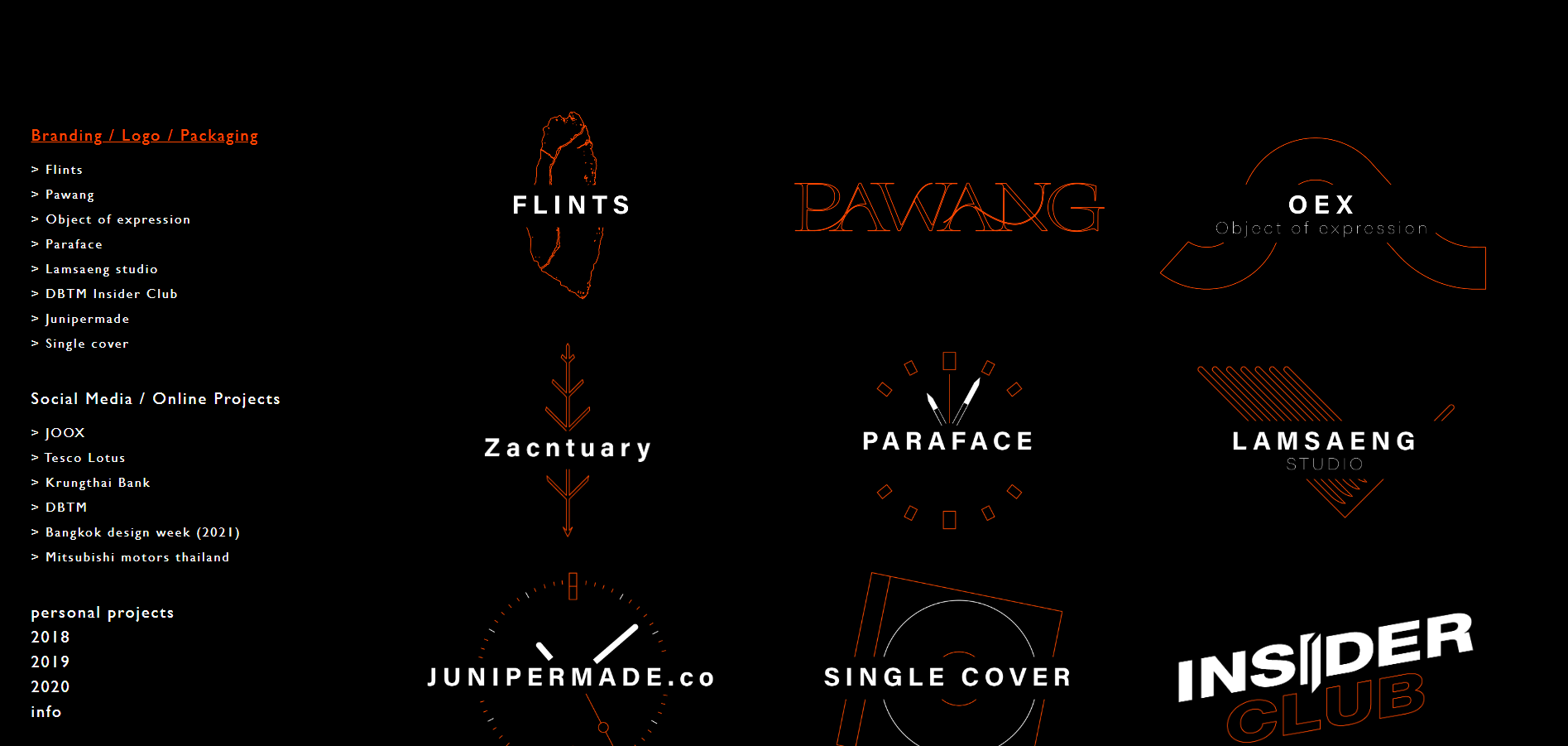
Get a head start on website creation with AI
Create a custom website tailored to your business needs 10X faster with 10Web AI Website Builder!
Ease of use
Ease of useReflects the platform’s overall user-friendliness.Score
Components:
- Learning curve (40%): Quickness and ease of getting started.
- Interface design (30%): Simplicity and intuitiveness of layout.
- User guidance (20%): Quality of tutorials and support.
- Flexibility (10%): Adaptability to various user skills.
 8.3
8.3
 8.1
8.1
🏆 Winner: Google Sites
. Scoring 8.3, Google Sites offers a slightly more user-friendly experience compared to Portfoliobox, which scores 8.1. Google Sites’ drag-and-drop interface and seamless integration with other Google services make it particularly accessible for users familiar with the Google ecosystem. Portfoliobox, while also user-friendly, is specifically designed for creative professionals and offers customizable templates and e-commerce capabilities.
Learning Resources
🏆 Winner: Google Sites
. Google Sites provides a wide array of learning resources, including practical guides for educators and comprehensive digital skill development programs. The platform’s extensive community presence further enhances its accessibility. Portfoliobox also offers a comprehensive suite of learning resources, including detailed articles and video guides, but its community presence is smaller in comparison.
For ecommerce
EcommerceMeasures the platform’s effectiveness in supporting online business activities.Score Components:
- Ecommerce themes and templates (20%): Variety and design of templates.
- Product management (25%): Ease of managing and organizing products.
- Payment options (25%): Variety and convenience of payment methods.
- Ecommerce features (20%): Features for managing an ecommerce store.
- Integration (10%): Compatibility with external e-commerce tools and services.
 1.8
1.8
 5.8
5.8
Google Sites is not inherently designed for ecommerce, lacking built-in features for online stores. It relies heavily on third-party integrations to add ecommerce functionalities, which can be cumbersome and less seamless. Portfoliobox, on the other hand, offers a more integrated ecommerce experience, specifically tailored for creative professionals looking to sell their work online.

|

|
|
|---|---|---|
|
Ecommerce themes and templates |
0.0 |
3.0 |
|
Product page customization |
0.0 |
6.0 |
|
Payment processing and commissions |
1.0 |
7.0 |
|
POS capabilities |
0.0 |
2.0 |
|
Payment gateways |
2.0 |
5.0 |
|
Product numbers |
0.0 |
5.5 |
|
Additional ecommerce features |
0.5 |
4.5 |
Google Sites ecommerce features:
- Google Sites itself does not have built-in eCommerce features.
Portfoliobox ecommerce features:
- Product listings
- Payment Gateways integrations
- Shipping rates and tax calculations
- Order management
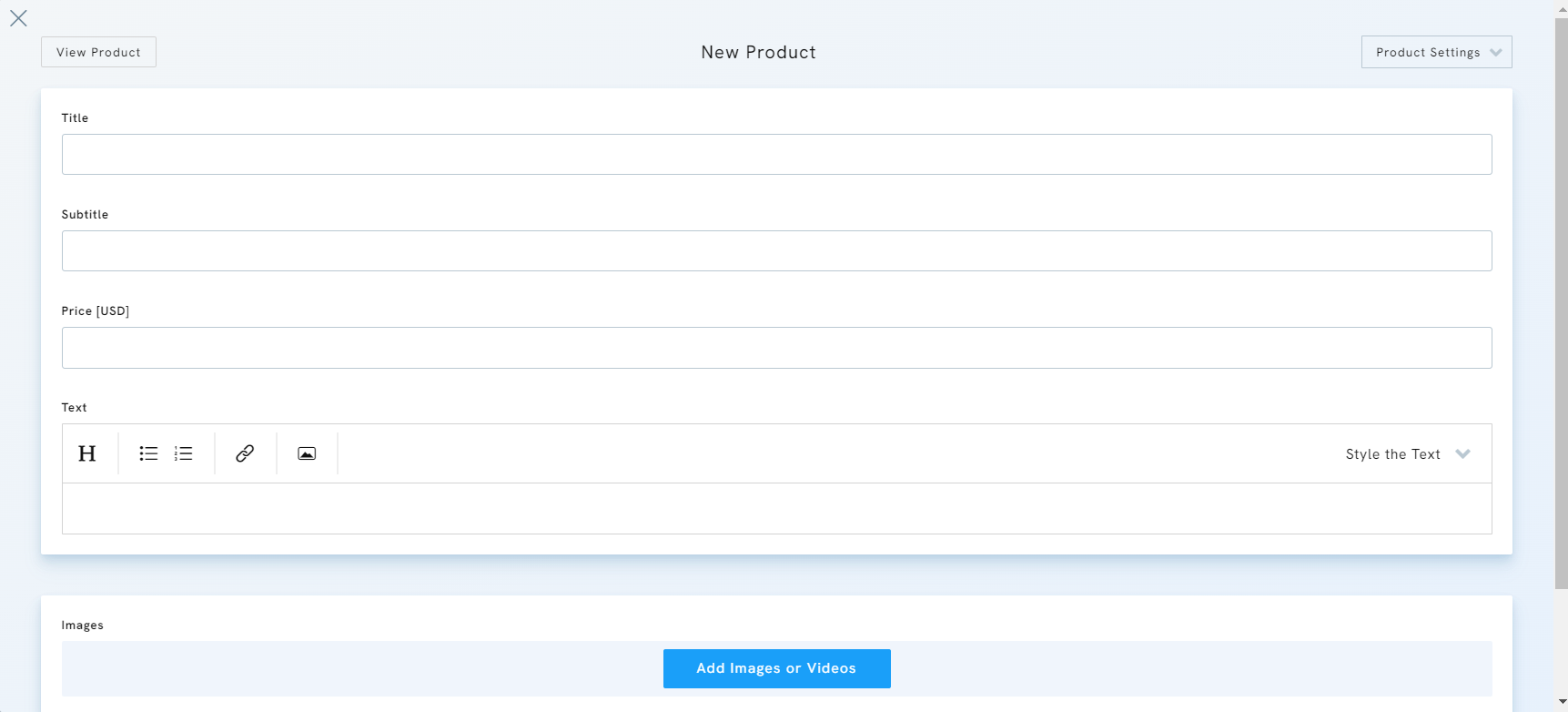
Ecommerce themes & templates
Google Sites does not offer any ecommerce-specific templates, making it less suitable for creating online stores. Portfoliobox also lacks ecommerce-specific templates but provides a variety of customizable templates that can be adapted for ecommerce purposes.
Product page customization
Google Sites lacks any product page customization features, as products can only be listed by embedding third-party platforms. All customization must be done within those external platforms. Portfoliobox offers a streamlined process for customizing product pages, allowing users to add details like title, description, media, set release dates, manage inventory, and apply discounts.
Payment processing
Google Sites requires the use of external tools or links to integrate payment gateways, such as embedding HTML code for payment buttons from services like PayPal, Square, or Stripe. This approach is less seamless compared to dedicated ecommerce platforms. Portfoliobox supports selling prints, art, craft, or services online without charging any commission for transactions. It accepts credit card payments (Visa, Master, & Maestro) for its subscriptions, implying these may also be supported for transactions within its ecommerce functionality.
In summary, while Google Sites can be adapted for ecommerce through third-party integrations, Portfoliobox offers a more cohesive and user-friendly ecommerce experience, making it a better choice for creative professionals looking to sell their work online.
Website Editors
Website EditorsEvaluates the platforms’ website building and editing capabilities.Score Components:
- Customization tools (40%): Range and power of editing features.
- Editor usability (30%): User experience within the editor.
- Design flexibility (20%): Freedom in layout and design changes.
- Update and maintenance ease (10%): Simplicity of updating and maintaining the site.
 7.0
7.0
 7.5
7.5
🏆
Winner: Portfoliobox
. Portfoliobox, with a score of 7.5, offers a user-friendly website builder tailored for creative professionals, providing an array of tools for building and customizing portfolio websites. Features include blog management with a commenting system, customizable image galleries with security options, and the ability to sell digital products. It also supports SEO optimization, social media, and analytics integration for enhanced online presence. While praised for its ease of use and variety of features, some users may find it limited for advanced, detailed content needs.
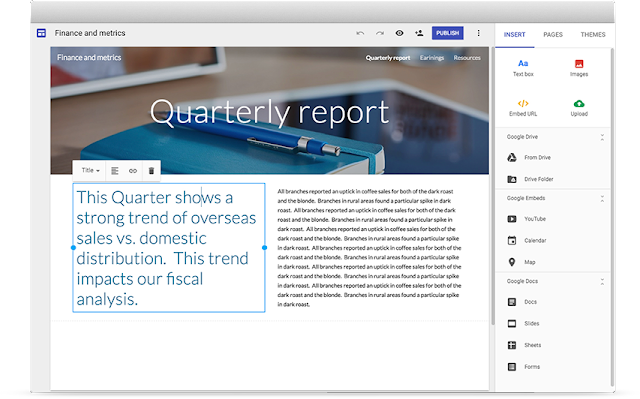
Google Sites, scoring 7.0, offers a user-friendly website builder editor that allows users to create and design websites without needing coding knowledge. With its drag-and-drop interface, users can easily add, customize, and arrange elements such as text, images, and videos on their web pages. It also provides a variety of templates and design options to help users get started quickly and ensure their site looks professional. Additionally, Google Sites integrates seamlessly with other Google services, enabling the incorporation of Google Docs, Sheets, Slides, and Maps directly into the website.
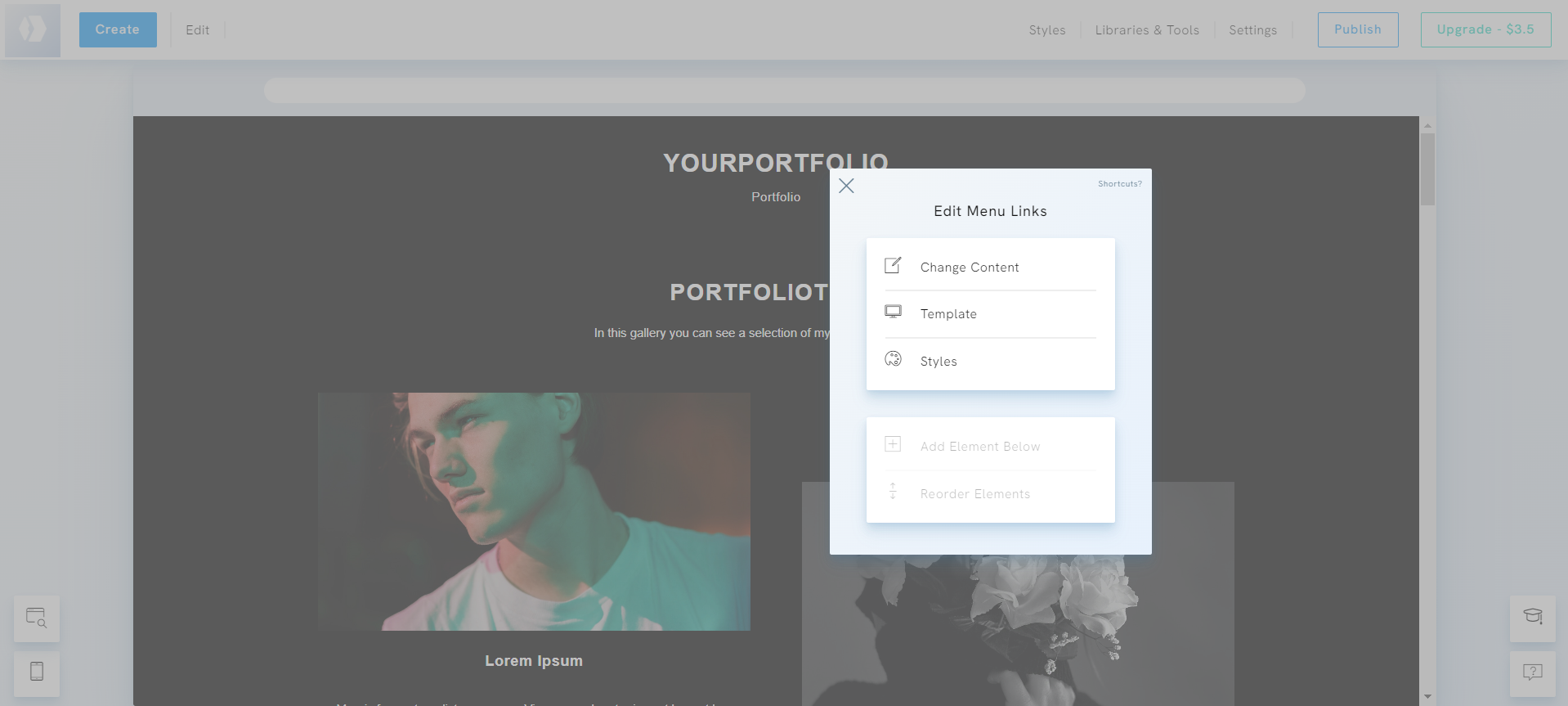
Mobile editor/app
 0
0
 0
0
🏆
Winner: None
. Both Google Sites and Portfoliobox do not offer dedicated mobile editor apps, which means users cannot directly edit their websites from a mobile device.
Google Sites focuses on simplicity and ease of use, allowing users to create and manage websites through a drag-and-drop interface. However, the lack of a mobile editor app limits the ability to make on-the-go adjustments, which can be a drawback for users needing to update their sites frequently.
Portfoliobox, designed for creative professionals, also lacks a dedicated mobile editor app. While it offers a user-friendly interface and a variety of customizable templates for desktop editing, the absence of mobile editing capabilities can be restrictive for artists and designers who may need to update their portfolios on the move.
In summary, both platforms are limited by the absence of mobile editor apps, making it necessary for users to rely on desktop interfaces for website management and updates.
Product testing options
Product Testing OptionsAssesses the options for trying out platform features before commitment.Score Components:
- Trial quality (40%): Extent and usefulness of the trial or free version.
- Feature accessibility (30%): How many features are available to test.
- Trial duration (20%): Length of the trial period.
- Ease of transition (10%): Smoothness of moving from trial to paid plans.
 6.9
6.9
 9.1
9.1
Overall Result
:
Portfoliobox wins
. Portfoliobox scores 9.1, significantly higher than Google Sites’ 6.9, offering a more comprehensive product testing experience. Portfoliobox provides a 30-day free trial with access to all features and a 14-day money-back guarantee, making it easier for users to fully explore the platform. Google Sites, while offering a free version and a 14-day trial, has limited premium feature testing and no money-back guarantee.

|

|
|
|---|---|---|
|
Free Plan |
Yes | No |
|
Trial Duration |
14 days | 30 days |
|
Testing Premium Features |
Limited within trial period | All features within trial period |
|
Money-back Guarantee |
No | 14-day money-back guarantee |
Price
PriceLooks at the cost-effectiveness and value for money of each platform.Score Components:
- Plan value (40%): What each pricing tier offers.
- Transparency and clarity (30%): Clearness of pricing structures.
- Flexibility of plans (20%): Range of options to suit different budgets.
- Hidden costs (10%): Additional expenses not included in the plan.
 8.1
8.1
 7.9
7.9
Google Sites offers a range of plans suitable for various business sizes, including an enterprise option, while Portfoliobox provides more affordable plans with significant discounts for annual billing.

|

|
|
|---|---|---|
|
$0-$10 |
Business Starter ($7.20/month): This plan includes basic features suitable for individuals or small businesses, offering professional email through Gmail, 30GB of storage per user, and video meetings for up to 100 participants. It allows to manage 1 website and there is no limitation on number of pages. Value for Price: 6.0 |
Light ($5.50/month): 50 Images, 10 Pages, 5 Products, 1 Password Protected Page, 1 Booking Service, 1 Scheduling Service, 1 Invoice, 1 QR Code, 25 mb File Sharing Value for Price: 6.0 |
|
$10-$15 |
Business Standard ($14.40/month): Suitable for growing businesses, this plan provides 2 TB of storage per user, video meeting capacity for up to 150 participants with recording features, and access to smart booking pages and shared drives. It allows to manage 1 website and there is no limitation on number of pages. Value for Price: 7.5 |
Pro ($14.50/month): 500 Images, 50 Pages, 10 Products, 2 Password Protected Pages, 2 Booking Services, 2 Scheduling Services, 2 Invoices, 2 QR Codes, 50 mb File Sharing, Customizable Templates, Free Custom Domain (yourname.com), 24/7 Support Value for Price: 7.5 |
|
$15+ |
Business Plus ($21.60/month): Designed for larger businesses needing more robust capabilities, offering 5 TB of storage per user, advanced security options, and video meetings for up to 500 participants. It allows to manage 1 website and there is no limitation on number of pages. Value for Price: 8.5 |
Pro Plus ($18.50/month): 1,000 Images, 1,000 Pages, 1,000 Products, 1,000 Password Protected Pages, 1,000 Booking Services, 1,000 Scheduling Services, 1,000 Invoices, 1,000 QR Codes, 5,000 mb File Sharing, Customizable Templates, Free Custom Domain (yourname.com), 24/7 Support, No “Powered by Portfoliobox” Link, Adobe Lightroom Integration Value for Price: 9.0 |
location. As a result in rare cases the prices displayed here can differ from the ones you see on their
websites.
Hosting quality
Hosting
qualityExamines the reliability and performance of the hosting solutions.Score Components:
- Uptime (40%): Consistency and reliability of website availability.
- Speed (30%): Loading times and performance.
- Bandwidth and storage (20%): Sufficiency of resources provided.
- Data centers (10%): Quality and distribution of hosting infrastructure.
 8.2
8.2
 6.5
6.5
🏆
Winner: Google Sites
. Google Sites offers robust cloud-based managed hosting with a 99.9% uptime guarantee and extensive global data centers, making it a reliable choice for various web projects. Portfoliobox, while user-friendly and designed for creative professionals, lacks transparency in uptime statistics and data center locations, resulting in a lower hosting quality score.

|

|
|
|---|---|---|
|
Do they offer hosting? |
Yes, basic storage with 100MB free per site, upgradeable via Google Workspace |
Yes, with unlimited bandwidth and secure communications through HTTPS on CDN servers |
|
Data Centers: |
Google operates a total of 21 data centers across the globe: 2 in Asia, 5 in Europe, 13 in US and 1 in South America |
Portfoliobox does not disclose the locations of its data centers |
|
Type of hosting: |
Cloud based managed hosting |
Managed Cloud Hosting |
|
Uptime: |
99.9% |
Portfoliobox does not disclose uptime statistics |
|
Uptime Guarantee: |
Yes, 99.9% |
No |
Website Speed Optimization
Website Speed OptimizationEvaluates optimization of website loading timesScore Components:
- PageSpeed Score (30%): Google’s score indicating performance optimization.
- Loading Time (30%): The average time until a website is fully interactive.
- Mobile Optimization (15%): Optimization effectiveness for mobile devices.
- Resource Optimization (15%): Optimizing images, scripts, and other heavy resources.
- CDN Usage (10%): Use of CDN to enhance speed across geolocations.
 3.3
3.3
 6.4
6.4
🏆 Winner: Portfoliobox
Both Google Sites and Portfoliobox have their own strategies for optimizing website speed, but Portfoliobox has a higher overall score in this category.

|

|
|
|---|---|---|
|
Focus |
Automated Optimization, CDN, Mobile Optimization, Browser Caching, Code Minification, Use of AMP |
CDN, Caching, Responsive Design |
|
Performance Tools |
Google PageSpeed Insights |
Google PageSpeed Insights |
|
Key Strategies |
Automated Optimization, CDN, Mobile Optimization, Browser Caching, Code Minification, Use of AMP |
CDN, Caching, Responsive Design |
|
Load Times |
Google does not disclose statistics about website Page Speed scores, or load times. |
Load times and PageSpeed scores vary depending on optimization |
|
Page Speed Scores Range |
Not disclosed |
Varies depending on optimization |
|
Core Web Vitals Improvement |
Emphasis on LCP, FID, CLS improvements |
Not provided |
Google Sites employs a range of strategies for speed optimization, including automated optimization, CDN, mobile optimization, browser caching, code minification, and the use of AMP. However, Google does not disclose specific statistics about website Page Speed scores or load times, making it difficult to gauge the real-world performance of sites built on this platform. Google Sites does emphasize improvements in Core Web Vitals, focusing on metrics like Largest Contentful Paint (LCP), First Input Delay (FID), and Cumulative Layout Shift (CLS).
Portfoliobox, on the other hand, focuses on CDN, caching, and responsive design to optimize website speed. While specific load times and PageSpeed scores are not provided, the platform’s strategies are designed to ensure that websites load quickly and perform well. Portfoliobox does not provide detailed information on Core Web Vitals improvements, but its higher overall speed optimization score suggests that it performs better in real-world scenarios compared to Google Sites.
Get a head start on website creation with AI
Create a custom website tailored to your business needs 10X faster with 10Web AI Website Builder!
Plugins and integrations
Plugins and integrationsMeasures the range and effectiveness of additional plugins and integrations.Score Components:
- Variety of options (40%): Range of available add-ons.
- Integration smoothness (30%): Ease of integrating plugins into the site.
- Quality of plugins (20%): Functionality and reliability of the options.
- Custom integration capabilities (10%): Support for custom or third-party integrations.
 6.4
6.4
 7.2
7.2
🏆 Winner: Portfoliobox.
Portfoliobox scores 7.2, outpacing Google Sites’ score of 6.4. Portfoliobox excels in offering a wide range of plugins and integrations, particularly suited for creative professionals looking to enhance their portfolios with advanced functionalities. Google Sites, while robust in its own right, primarily focuses on integrating Google services and basic widgets, making it less versatile compared to Portfoliobox.
It is however worth mentioning that Google Sites offers seamless integration with various Google services, which can be a significant advantage for users already embedded in the Google ecosystem.

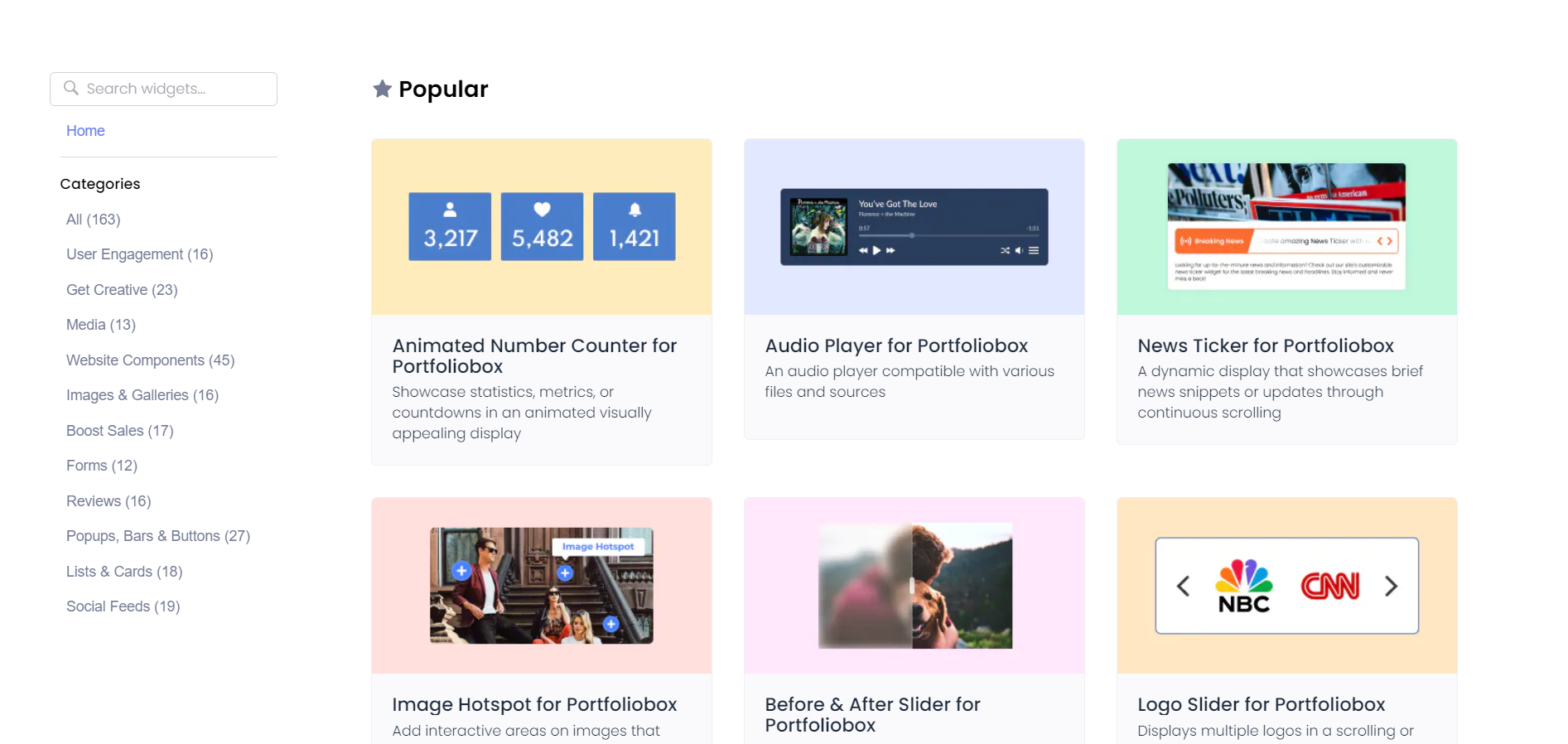
Marketing Features
Design FunctionalitiesRepresents how well each platform allows for creative design and customization of websites.Score Components:
- Template Variety (30%): Range and quality of design templates.
- Customization (30%): Flexibility and options for design alterations.
- User Interface (20%): Ease and intuitiveness of the design process.
- Responsiveness (10%): Adaptability to different devices and screen sizes.
- Innovation (10%): Unique design features and tools.
 2.6
2.6
 7.0
7.0
🏆
Overall Winner: Portfoliobox
. Portfoliobox excels with its comprehensive marketing tools, including email marketing, blogging, and advanced social media integration, making it ideal for creative professionals. Google Sites, while easy to use and integrated with Google services, lacks many advanced marketing features.

|

|
|
|---|---|---|
|
SEO Tools |
Basic SEO settings |
✓ |
|
Email Marketing |
No |
✓ |
|
Blogging |
No |
✓ |
|
Social Media Integration |
Basic integration through manual methods |
Comprehensive integration with social media platforms |
|
Analytics and Reporting |
Google Analytics integration |
Comprehensive analytics with Google Analytics and Facebook Pixel integration |
|
Ads and Promotions |
No | No |
Customer Support
Customer supportEvaluates the quality and availability of support options.Score Components:
- Response time (40%): Speed of support responses.
- Support quality (30%): Effectiveness and helpfulness of the support.
- Availability (20%): Range of support channels (phone, chat, email).
- Resource richness (10%): Quality of self-help and educational materials.
 7.2
7.2
 7.0
7.0
🏆 Winner: Google Sites
. When comparing Google Sites vs Portfoliobox, Google Sites takes the lead in customer support. Google Sites offers a range of self-service resources, including a Help Center and community forums, which are accessible to all users. For Google Workspace customers, direct support options such as phone, email, and live chat are available, with 24/7 support for critical issues depending on the subscription tier. This makes Google Sites a versatile option for users needing varying levels of support.
Portfoliobox, on the other hand, provides 24/7 customer support, ensuring that users can receive help at any time. While this is a significant advantage, Portfoliobox lacks specialized enterprise support, which may be a limitation for larger organizations. However, for individual creative professionals and small businesses, Portfoliobox’s round-the-clock support can be highly beneficial.
Security
SecurityLooks at the platforms’ security measures and data protection.Score Components:
- Data protection (40%): Safeguards for user and customer data.
- SSL and encryption (30%): Implementation of secure connections.
- Compliance (20%): Adherence to industry security standards.
- Regular updates (10%): Frequency of security updates and patches.
 9.3
9.3
 8.1
8.1
🏆
Winner: Google Sites
. Google Sites excels in security with a comprehensive suite of measures, including SSL encryption, two-factor authentication, and automatic malware scanning. The platform benefits from Google’s robust infrastructure, which includes regular security updates, DDoS protection, and compliance with international data protection standards. These features ensure a secure environment for both website creators and visitors, making Google Sites a reliable choice for those prioritizing security.
Portfoliobox also offers solid security features, such as free SSL certificates for all domains and two-factor authentication for key actions within the Dashboard. While it provides a secure environment for creative professionals to showcase their work, its security score is slightly lower than that of Google Sites. Nonetheless, Portfoliobox remains a dependable option for users seeking to protect their data and maintain secure connections.
AI Capabilities
AI capabilitiesMeasures the effectiveness of AI-driven features and tools.Score Components:
- Automation efficiency (40%): Impact of AI on streamlining processes.
- Personalization (30%): AI-driven customization for users or customers.
- AI-Assisted design (20%): Role of AI in website design and functionality.
- Data analysis (10%): Use of AI in interpreting user data and analytics.
 0
0
 0
0

|

|
|
|---|---|---|
|
AI Builder |
None |
None |
|
AI Ecommerce Features |
None |
None |
|
AI Content Generation |
None |
None |
|
Additional AI Features |
None |
None |
🏆 Winner: None
. Both Google Sites and Portfoliobox do not offer any AI capabilities. This means that users looking for AI-driven features such as automated design, content generation, or advanced analytics will need to consider other website builders.
User Management
User ManagementAssesses the platforms’ capabilities in managing user roles, permissions, and accessibility.Score Components:
- Role Customization (40%): Flexibility in creating and defining user roles and
permissions. - Ease of Management (30%): User interface and tools for managing users.
- Access Control (20%): Effectiveness of access control measures for different user
levels. - Scalability (10%): Ability to manage a growing number of users efficiently.
 7.8
7.8
 2.8
2.8
🏆 Winner: Google Sites
. When it comes to managing users, Google Sites offers a more robust and flexible system compared to Portfoliobox.
- Google Sites allows multiple users to collaborate with different roles, including Owners, who have full control, and Editors, who can modify content but not site settings. There’s no strict limit on the number of users who can edit a site, allowing flexibility in management and development. Viewers can only see the site, with no editing permissions. This structure supports collaborative website building with varied levels of access and control for different users.
- Portfoliobox, on the other hand, allows only one user to manage and edit a website, which can be limiting for teams or collaborative projects.
Google Sites User Management:
| Role | Description | Access Highlights |
|---|---|---|
| Owners | Full control over the site | Manage settings and user management. |
| Editors | Can modify content | Cannot change site settings. |
| Viewers | Can only view the site | No editing permissions. |
Portfoliobox User Management:
| Role | Description | Access Highlights |
|---|---|---|
| Single User | Full control over the website | Manage and edit the website. |
Additional Features

|

|
|
|---|---|---|
|
SSL Certificate |
✓ |
✓ |
|
Custom Domain |
✓ |
✓ |
|
Free Custom Domain Included |
✓ |
✓ |
|
International Domains |
✓ |
✓ |
|
Mobile Responsive |
✓ |
✓ |
|
Page Speed |
✓ |
✓ |
|
Website Builder Mobile App |
X |
X |
|
Convert a Website To An App |
X |
X |
|
Website Analytics |
✓ |
✓ |
|
Multilingual Sites |
✓ |
✓ |
|
Multiple Users |
✓ |
X |
User Feedback
Users consistently praise Google Workspace, particularly Google Sites, for its seamless integration, ease of use, and collaborative features, making it a go-to solution for various professional and educational needs. The platform’s simplicity and user-friendly interface are lauded, enabling effortless website creation and sharing of information within organizations. While some users desire more customization options and additional features, overall, Google Workspace remains highly valued for its versatility and streamlined workflow facilitation.
Users overwhelmingly appreciate Portfoliobox for its user-friendly interface, making it straightforward for both beginners and professionals to create and manage online portfolios. The platform’s customizable design options, responsive layouts, and diverse template selection stand out as significant advantages, allowing users to express their personal style and showcase their work effectively across devices. However, some critiques include limited template options compared to competitors, a learning curve for less tech-savvy users, and minor glitches with features like autosave on different devices. Despite these challenges, the positive impact of Portfoliobox on users’ ability to present their work to potential clients and employers, along with its value in making portfolio creation accessible without coding knowledge, is consistently highlighted.
The making of this blog
We followed a clear, step-by-step process to write and research this article.
FAQ
Which platform is better for creative professionals, Google Sites or Portfoliobox?
Can I use both Google Sites and Portfoliobox for team projects?
How do Google Sites and Portfoliobox compare in terms of ecommerce functionality?
What are the main differences in pricing between Google Sites and Portfoliobox?










